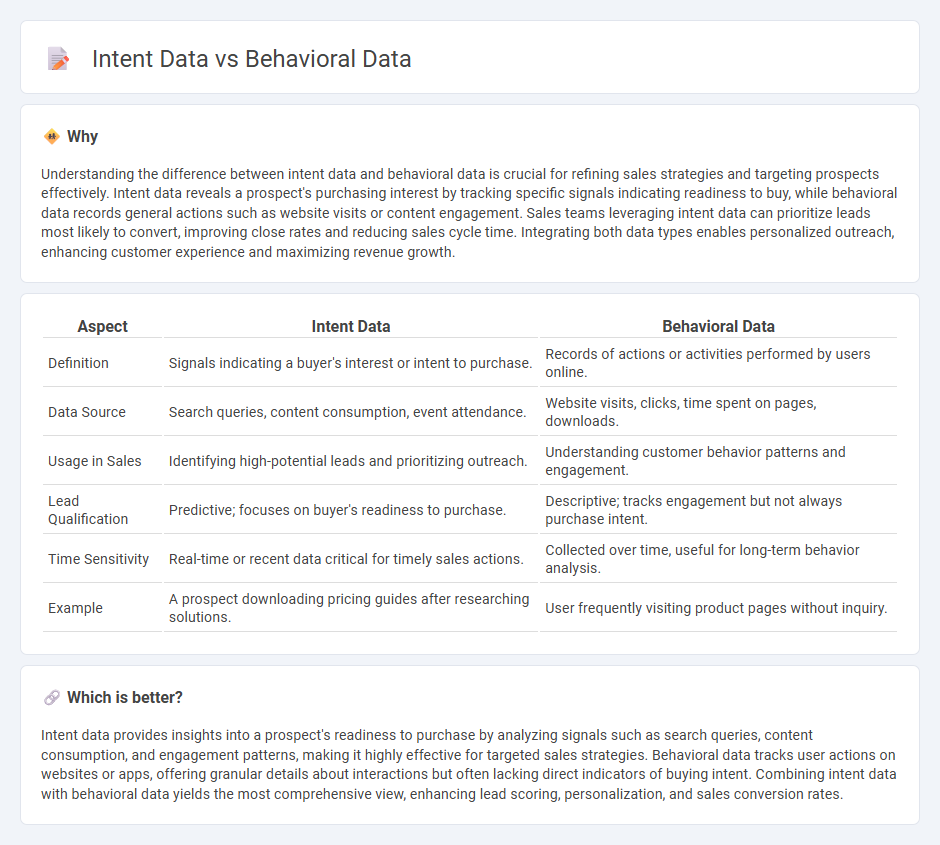
Intent data reveals prospects' future buying signals by analyzing expressed interests and search behaviors, while behavioral data tracks actual interactions such as clicks, visits, and purchases. Leveraging intent data allows sales teams to prioritize leads showing early purchase intent, whereas behavioral data helps refine engagement strategies based on customer actions. Explore how combining intent and behavioral insights can significantly boost your sales performance.
Why it is important
Understanding the difference between intent data and behavioral data is crucial for refining sales strategies and targeting prospects effectively. Intent data reveals a prospect's purchasing interest by tracking specific signals indicating readiness to buy, while behavioral data records general actions such as website visits or content engagement. Sales teams leveraging intent data can prioritize leads most likely to convert, improving close rates and reducing sales cycle time. Integrating both data types enables personalized outreach, enhancing customer experience and maximizing revenue growth.
Comparison Table
| Aspect | Intent Data | Behavioral Data |
|---|---|---|
| Definition | Signals indicating a buyer's interest or intent to purchase. | Records of actions or activities performed by users online. |
| Data Source | Search queries, content consumption, event attendance. | Website visits, clicks, time spent on pages, downloads. |
| Usage in Sales | Identifying high-potential leads and prioritizing outreach. | Understanding customer behavior patterns and engagement. |
| Lead Qualification | Predictive; focuses on buyer's readiness to purchase. | Descriptive; tracks engagement but not always purchase intent. |
| Time Sensitivity | Real-time or recent data critical for timely sales actions. | Collected over time, useful for long-term behavior analysis. |
| Example | A prospect downloading pricing guides after researching solutions. | User frequently visiting product pages without inquiry. |
Which is better?
Intent data provides insights into a prospect's readiness to purchase by analyzing signals such as search queries, content consumption, and engagement patterns, making it highly effective for targeted sales strategies. Behavioral data tracks user actions on websites or apps, offering granular details about interactions but often lacking direct indicators of buying intent. Combining intent data with behavioral data yields the most comprehensive view, enhancing lead scoring, personalization, and sales conversion rates.
Connection
Intent data reveals potential customers' interests by tracking their online activities, while behavioral data captures broader actions such as clicks, downloads, and time spent on pages. Combining these datasets enhances sales teams' ability to identify high-value leads and tailor personalized outreach strategies. Companies leveraging both data types experience higher conversion rates and improved sales pipeline efficiency.
Key Terms
Actions Taken (Behavioral Data)
Behavioral data captures actions taken by users, such as clicks, page visits, and purchase history, providing insights into their actual engagement patterns. Intent data reveals users' interests and potential future behavior based on signals like search queries and content consumption. Discover how integrating behavioral data with intent data can enhance targeting and personalization strategies.
Purchase Signals (Intent Data)
Purchase signals in intent data capture specific behaviors indicating a buyer's readiness, such as product page visits, price comparisons, and cart additions, which provide more precise insights than general behavioral data. Behavioral data includes broader patterns like time spent on site or content engagement but lacks the targeted indication of imminent purchase present in intent data. Explore how leveraging purchase signals can enhance your sales and marketing strategies by aligning efforts with genuine customer intent.
Engagement Level
Behavioral data captures user actions and interactions, such as clicks, page views, and time spent on site, reflecting actual engagement level with content. Intent data indicates a user's likelihood to convert by analyzing signals like search queries, content consumption patterns, and digital footprints across platforms. Explore the differences in engagement insights provided by behavioral versus intent data to enhance targeted marketing strategies.
Source and External Links
What is Behavioral Data & Why is it Important? - Fullstory - Behavioral data captures how customers interact with a business (e.g., page views, clicks, purchases) across various platforms and powers personalization, analytics, and AI-driven predictions for improved customer experience.
Understanding Behavioral Data: A Comprehensive Guide - Statsig - Behavioral data objectively tracks user actions within products or services, revealing preferences and habits to help businesses optimize experience, boost engagement, and drive growth.
What is Behavioral Data? The Complete Guide | Hightouch - Behavioral data includes detailed customer interactions such as clicks, scroll depth, and form submissions, enabling real-time analysis and data-driven decisions to improve targeting and predict customer behavior.
 dowidth.com
dowidth.com